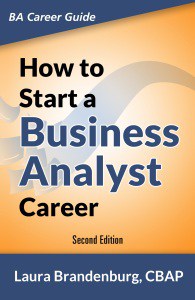While business analysis as a collection of activities has been around for decades, preceding even the introduction of the International Institute of Business Analysis™ (IIBA®) in 2004, business analysis, as a discipline, has evolved significantly during the last 5 years.
Because looking back can help us look forward with more clarity and confidence, in this article we’ll look at 5 ways the profession has changed since 2009 or in the 5 years since the first edition of How to Start a Business Analyst Career was published.
Change 1: New Business Analysis Certifications
While the IIBA® Certified Business Analysis Professional™ (CBAP®) certification has been available since 2004, two new certifications have been created in the last 5 years.
- First, IIBA® introduced the Certification of Competency in Business Analysis™ (CCBA®) in 2011, providing a certification option for business analysis without the extensive work history required by the CBAP®.
- Second, Project Management Institute (PMI)® released the Professional in Business Analysis (PMI-PBA)℠ certification in 2014, providing a certification option for business analysts who work primarily inside projects and programs.
New certifications mean a growing awareness of the business analysis profession, along with professionals having options when it comes to adding to their individual credibility. What’s more, the new options have lesser work experience requirements, making certification a more viable option for more professionals relatively new to business analysis. As we look forward, the number of business analysis professionals will continue to grow.
Accordingly, the second edition of How to Start a Business Analyst Career contains a new section on certifications and how they can fit into your career planning.
Change 2: Expanded Set of Business Analyst Job Roles
Despite what we might like to see as business analysis professionals, business analyst job roles are still specialized. In the last 5 years, we’ve seen this pattern become entrenched within the profession, and experienced an increased number of flavors of business analyst job roles.
In the second edition of How to Start a Business Analyst Career, the discussion of specializations was expanded and several examples of how to leverage and highlight your industry and domain experience were included.
The new job roles added include:
- Business Intelligence Analyst
- Business Process Analyst
- Systems Analyst
- Product Owner
The book further explores specializations by splitting apart Industry-Focused, Tool-Specific, and Functional Domain-Focused Business Analyst Roles, which were all covered in the first edition, but not with as much depth.
As more organizations recognize the value of business analysts and look to increase the value provided by their business analysts, I think we’ll continue to see specializations expand, at least at the mid-level and senior-level roles.
Change 3: Increased Focus on Business Process
Although the vast majority of business analyst jobs fit within the IT Business Analyst job description, the business analyst role itself has seen an increased focus on business process. I know in my early days as a business analyst, a lot of product decisions were necessarily driven by technical constraints.
While we haven’t obliterated technical constraints, they tend to have a much less significant role in our early requirements discussions and we are free to explore more in the way of business needs and opportunities. This means business analysts are involved not just in analyzing and specifying software requirements, but also with understanding current state business processes, helping plan business process improvements and changes, and driving the implementation inside the business user community.
For many business analysts, these changes have resulted in a subtle expansion of their role. For others, they’ve found themselves drawn to one side or the other in yet another specialization force within the profession.
Rest assured, we’ve got you covered in the second edition, with additional skills for process analysts, a deeper focus on collaboration techniques, and an entirely new Underlying Core Competencies section. I also updated the discussion of the Business-IT balance specifically to address some of the shifts we are seeing in business analysis work.
Change 4: Increased Adoption of Agile Practices
Five years ago, agile practices were beginning to transition from the latest fad to a respectable trend. The business analysis community was just starting to get engaged in the discussion. As of 2014, the majority of business analysts I talk to have experienced or are working in agile teams. That’s because agile is much more widely accepted and adopted now as a discipline.
Strangely enough, despite historical claims that agile does away with business analysts, we only see positive signs for the business analysis profession so these two disciplines must be co-mingling.
In the first edition of the book, I was unable to cite any resources specifically looking at the intersection of business analysis and agile. Thankfully, this gap has been filled in many ways, and there are several relevant resources suggested in the updated text. The most prominent resource is Discover to Deliver: Agile Product Planning and Analysis, co-authored by Mary Gorman and Ellen Gottesdiener, who also contributed a foreword to the second edition of How to Start a Business Analyst Career.
And while agile is clearly the way of the future, the book still contains a discussion of waterfall and iterative approaches because we still see many business analysts working in environments that approach projects in this way.
Change 5: Increased Awareness of the Business Analysis Profession
Obviously we are still fighting many battles to have our value, skills, and experience appropriately recognized. However, there are many signs that awareness of business analysis is growing.
Let’s look at a few key indicators:
- In 2010 the average business analyst salary as reported by the IIBA® salary survey, was $82,493 in the United States. In 2013, the average US salary for a business analyst rose nearly $10,000 to $91,514.
- Membership in the primary organization for business analysts – IIBA® – rose from 5,000 in 2008 to over 28,000 in 2014.
- There were numerous mentions of roles related to business analysis on top job lists, albeit often under titles such as Computer Systems Analyst, Management Consultant, and Business Technology Analyst.
Everywhere you turn, business analysis is being recognized where it was previously ignored or rising where it was previously under-valued. This doesn’t mean that we don’t individually experience frustration, but overall the tides have turned and are building in a very positive way.
And What Hasn’t Changed (Much)
Despite all the steps forward in the last 5 years, there are still some aspects of business analysis that haven’t changed all that much.
There is still a dizzying array of job titles referring to business analyst jobs and myriad job responsibilities included inside business analyst jobs. The section on hybrid roles was actually expanded to more fully address the challenges an aspiring business analyst faces when exploring job options.
Another aspect of business analysis that hasn’t changed much – and I see this as a positive – are the fundamentals. Here are two sentences that are exactly the same in both the first and second edition of the book.
“What is not going to change all that much are the fundamentals of business analysis. If you focus on learning the fundamentals and work your way through a few projects, you will reach a point where you have mastered the basic techniques but can keep on refining the art. “
And while refined and re-organized, the core business analyst skills and related business analysts skills lists remain essentially the same between the two editions.
It’s Our Time
After taking this look back through the profession, I’m energized because there seems to be so much momentum behind what we are doing in business analysis. I’m happy to see some of the positive changes – the growth in awareness and salary – along with the wider range of opportunities that are available to me with my business analysis background.
To me, this means that the work I love to do and love to help others do will continue to be valued and rewarded for a long time to come. It means that we will all have more opportunities to make a positive impact in our teams, organizations, and last, but certainly not least, our careers.

As business analysts get better, the world gets better.
I’m proud to be part of the business analyst community and to offer this new resource to help more talented professionals expand their opportunities in business analysis.
Click here to learn more about the book
